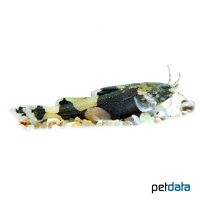Orange-Banded Hillstream Catfish (Akysis vespa)
| Orange-Banded Hillstream Catfish Akysis vespa | |
|---|---|
| Name | Orange-Banded Hillstream Catfish |
| Name Lat. | Akysis vespa |
| Family | Stream Catfishes |
| Family lat. | Akysidae |
| Order | Catfishes |
| Order lat. | Siluriformes |
| Origin | Asia |
| Habitat | Streams |
| Diet | Carnivore |
| pH | 6.0-7.5 |
| Behavior | Peaceful |
| Keeping | Group |
| Care Level | Moderate |
| Reproduction | Oviparous |
| Breeding | None reported |
| Life Span | 6-10 years |
| Protection | No |
| Metric Units | |
| Size | 2.5-3.5 cm |
| Temperature | 16-24 °C |
| Hardness | 2-12 °dH |
| Aquarium | 60 cm / 54 l |
| US Units | |
| Size | 1"-1.4" |
| Temperature | 61-75 °F |
| Hardness | 36-214 ppm |
| Aquarium | 15 gal |
Distribution and habitat
The Bumblebee Dwarf Catfish are found exclusively (endemically) in the upper inlet of the Salween River on the border of Myanmar and Thailand. There they live in fast flowing streams and small rivers with a substrate of sand, gravel and stones as well as sunken roots and branches.
Maintenance
They need an aquarium with border planting, many hiding places like stone caves (e.g. perforated rock) and roots as well as sufficient swimming space. A dark substrate of sand and fine gravel covered with some foliage (sea almond tree, beech), subdued light (floating plants) and oxygen-rich water with a moderate current is ideal.
No ammonia, ammonium and nitrite should be detectable, and the nitrate value should not exceed 100 mg/l. To ensure the water quality and oxygen content, a filter and heater adapted to the aquarium size is required, as well as lighting for the species-appropriate day-night rhythm of the animals.
Diet
The food supply consists of live food, such as cyclops, daphnia, artemia, enchytraea and mosquito larvae, which are also eaten frozen without problems, or a commercially available frozen food mix. Not too fine sea water plankton (frozen or preserved) is also gladly accepted. After habituation, protein-rich dry food (granules, micro-pellets) is sometimes also accepted. They are nocturnal fish and should only be fed in the evening.
Only feed as much as will be eaten within a few minutes. A regular and varied diet promotes health and increases resistance.
Behaviour and compatibility
It is recommended to keep these calm fish in a group of at least 5 animals. They are very peaceful and should only be kept together with other calm and small fish, such as Boraras. Socialization with larger, bottom-dwelling or nocturnal fish as well as shrimp is not recommended
Basically, only compatible fish species with similar requirements for water conditions and water temperature may be socialized.
Sex dimorphism
The sexes are hardly distinguishable. Females ready to spawn appear rounder. With some experience the sexes can be distinguished by their genital papilla.
Reproduction and breeding
Sporadic reproduction in the aquarium has been successful. The larvae hatch after about 4 days and swim freely after another 10 days
During the first weeks the tiny fry have to be fed several times a day with infusoria or a commercial liquid rearing food. Breeding is hardly possible in community tanks, as the fry are easy prey
Important
They have venomous dorsal and pectoral fin spines that can cause painful injuries when touched.
When catching them, use nets with as fine a mesh as possible so that the hard rays of the fins do not get caught in them.
Foliage (sea almond tree, oak, etc.) not only provides cover, but as it rots it encourages the development of microorganisms that provide a valuable secondary food source.
The well-being of the fish should be monitored regularly. Temperature should be checked daily, pH, hardness and nitrate levels at least every 14 days. Regular partial water changes are recommended, even when contaminant levels have not yet reached the upper limit. Sudden changes in water quality should be avoided. Newly introduced fish must be accustomed slowly to the water in the aquarium.
Further literature can be found in your pet store.
References
Text: Werner Winter; Image: petdata
Source: BMELV (1998): Tierschutzgutachten - Haltung von Zierfischen (Süßwasser); ENGELMANN (2005): Zootierhaltung - Tiere in menschlicher Obhut: Fische, Verlag Harri Deutsch
- Gemäß § 21 Abs. 5 Tierschutzgesetz idgF
